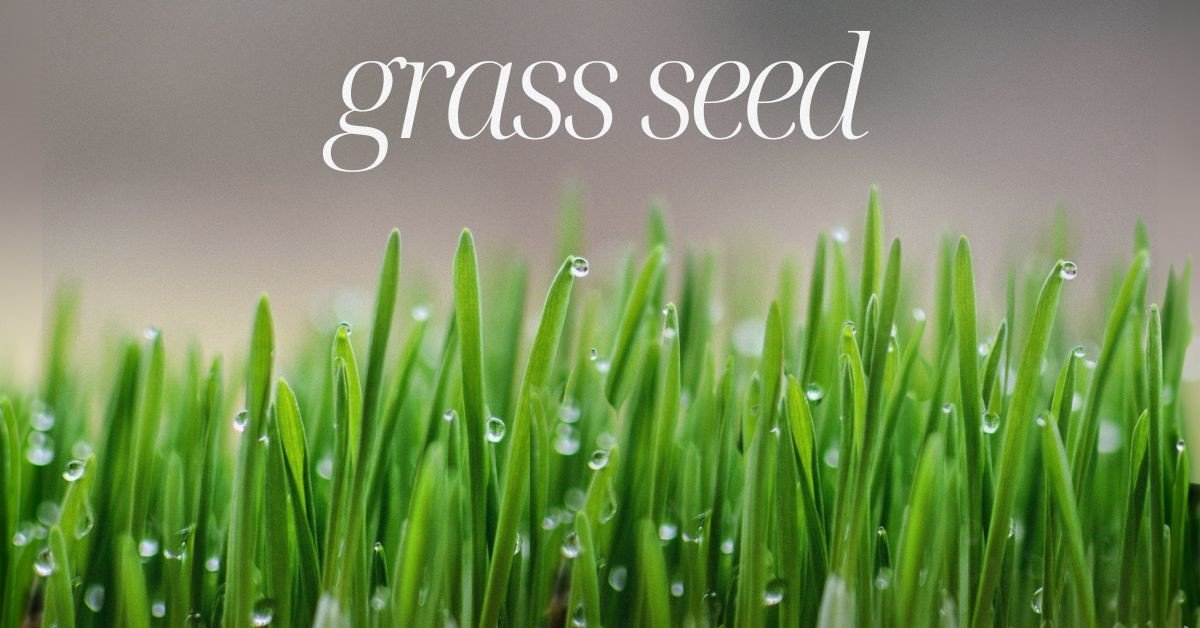Blog
Growing a Perfect Lawn: The Ultimate Guide to Grass Seed

A lush, green lawn is a symbol of beauty, care, and pride for any homeowner. Whether you’re starting a new lawn from scratch or filling in bare patches, grass seed plays a vital role in achieving that picture-perfect yard. Choosing the right type, preparing the soil, and maintaining proper care can make all the difference between a sparse patch and a vibrant carpet of green. This guide explores everything you need to know about grass seed—from selection to sowing and long-term maintenance—so you can grow the healthy lawn of your dreams.
What Is Grass Seed?
Grass seed is a collection of small seeds from various grass species cultivated for lawns, sports fields, or landscaping. Each seed type has unique characteristics—some thrive in cool climates, others in warm regions. When sown properly, these seeds germinate and grow into dense grass, creating a smooth, green surface that enhances your home’s outdoor appeal and provides a soft area for recreation.
Rrad More: Dry and Wet: Understanding the Essential Contrast of Nature
Different Types of Grass Seed
Grass seed varieties are generally classified into cool-season and warm-season types. Cool-season grasses—like Kentucky Bluegrass, Fescue, and Ryegrass—grow best in northern regions with cold winters and moderate summers. Warm-season grasses—like Bermuda, Zoysia, and St. Augustine—flourish in southern climates where heat and sunlight are abundant. Choosing the right type for your climate ensures healthy growth year-round.
Understanding Your Climate Zone
Climate has a direct impact on how well your grass grows. Before buying seed, determine your region’s climate zone. For example, cool-season grasses suit areas with snowy winters and mild summers, while warm-season varieties thrive in hot, humid conditions. Some regions known as transition zones can support both types, depending on local weather and soil conditions.
Choosing the Right Grass Seed for Your Lawn
Selecting the right seed depends on several factors—climate, soil type, sun exposure, and lawn usage. For shady areas, fine fescue or shade-tolerant blends are ideal. For high-traffic lawns, perennial ryegrass or Bermuda grass performs well due to durability. If you prefer low maintenance, choose slow-growing species like Zoysia. Reading seed labels carefully ensures you pick a blend that fits your needs.
Preparing the Soil for Planting
Healthy soil is the foundation of a thriving lawn. Start by clearing the area of debris, weeds, and rocks. Loosen the top few inches of soil using a rake or tiller to improve air and water penetration. Test the soil’s pH level—it should be between 6.0 and 7.0 for most grass types. Adding compost or fertilizer enriches the soil with nutrients and enhances seed germination.
How to Plant Grass Seed Properly
For best results, sow your grass seed evenly across the prepared soil using a spreader. Lightly rake the surface to cover seeds with a thin layer of soil, then water gently to keep it moist. Avoid heavy watering, which can wash away seeds. For large lawns, dividing the area into sections helps ensure even coverage. Consistent moisture during the first few weeks is key for successful germination.
When Is the Best Time to Plant Grass Seed?
Timing is crucial for successful lawn growth. Cool-season grasses should be planted in early spring or early fall when temperatures are mild. Warm-season grasses, on the other hand, grow best when planted in late spring or early summer, as they require warm soil for germination. Avoid sowing during extreme weather conditions, as seeds may fail to sprout.
Watering Tips for New Grass Seed
Proper watering is essential for new seeds to take root. Keep the soil consistently moist, watering lightly 2–3 times a day until the grass reaches about two inches in height. Once the grass establishes, reduce watering to once a day, ensuring deep, thorough soaking. Overwatering can cause rot, while underwatering may dry out seeds before they germinate.
Fertilizing Grass Seed for Healthy Growth
Fertilizing provides the nutrients needed for strong root development and vibrant color. Apply a starter fertilizer when planting and follow up with balanced fertilizer every 6–8 weeks during the growing season. Avoid over-fertilizing, as excessive nitrogen can burn young grass or lead to uneven growth. Organic options like compost or manure also enrich the soil naturally.
Protecting Grass Seed from Birds and Pests
Freshly planted seeds often attract birds and insects. To protect them, cover the soil with a thin layer of straw mulch or a biodegradable seed blanket. This not only deters birds but also retains moisture and regulates temperature. You can also use natural repellents or netting to keep pests away until the grass begins to sprout.
Mowing New Grass for the First Time
Wait until the Grass Seed reaches about three inches in height before mowing for the first time. Use a sharp mower blade and cut only the top third of the grass to avoid damaging tender roots. Gradually lower the mowing height as the lawn matures. Regular mowing encourages dense, healthy growth and prevents weeds from taking over.
Dealing with Patchy or Uneven Growth
Even with careful planting, some areas may grow unevenly. To fix bare spots, lightly rake the area, reseed, and water consistently. Using the same seed variety ensures uniform color and texture. Sometimes, patchy growth results from poor soil quality or uneven watering—addressing these factors ensures smoother regrowth.
Aerating and Overseeding for Long-Term Lawn Health
Over time, soil compaction can limit root growth and water absorption. Aeration—the process of creating small holes in the soil—improves oxygen and nutrient flow. Pairing aeration with overseeding rejuvenates thin lawns, filling gaps and increasing density. The best time for this is early fall or spring when temperatures favor seed growth.
Common Mistakes to Avoid When Planting Grass Seed
Many homeowners make simple mistakes that hinder growth. Planting too deeply, using the wrong seed for the climate, or failing to water consistently can cause poor germination. Skipping soil testing or ignoring pH balance also limits nutrient absorption. Understanding these common pitfalls helps you achieve a greener, healthier lawn.
Grass Seed vs. Sod: Which Is Better?
While grass seed is more affordable and allows for deeper root development, sod provides instant results. However, sod is costlier and requires careful installation. Seeded lawns grow naturally and adapt better to local soil, while sod offers quick coverage. Your choice depends on budget, time, and desired results.
Maintaining a Healthy Lawn Year-Round
Once your grass matures, regular maintenance keeps it lush. Mow regularly, water deeply, and fertilize seasonally. Remove weeds promptly and aerate annually. Adjust watering and mowing schedules according to seasonal changes. With consistent care, your lawn will remain vibrant and healthy throughout the year.
Conclusion
Growing a healthy, green lawn starts with the right grass seed and proper care. By choosing the right type for your climate, preparing the soil well, and maintaining a consistent watering and feeding schedule, you can transform your yard into a thriving outdoor oasis. Patience and attention to detail pay off—each blade of grass you nurture contributes to a beautiful, enduring lawn that enhances your home’s appeal and offers endless outdoor enjoyment.
Read More: Buffalo Food: Exploring What and How These Giants Eat
FAQs
1. How long does it take for grass seed to grow?
Most grass seeds germinate within 7–21 days, depending on the variety, soil temperature, and watering consistency.
2. Should I cover grass seed after planting?
Yes, lightly cover it with soil or straw mulch to protect it from birds and retain moisture for germination.
3. Can I plant grass seed in winter?
It’s not recommended. Seeds need warm soil to germinate effectively. Wait until spring or fall for best results.
4. How often should I water new grass seed?
Water lightly 2–3 times a day until seedlings establish, then reduce to once daily or as needed.
5. What’s the difference between seed mixes and pure grass seed?
Seed mixes combine several grass types for varied conditions, while pure seed consists of a single species suited to specific needs.
-

 Tech1 year ago
Tech1 year agoHow to Use a Temporary Number for WhatsApp
-

 Business2 years ago
Business2 years agoSepatuindonesia.com | Best Online Store in Indonesia
-

 Social Media1 year ago
Social Media1 year agoThe Best Methods to Download TikTok Videos Using SnapTik
-

 Technology1 year ago
Technology1 year agoTop High Paying Affiliate Programs
-

 Tech9 months ago
Tech9 months agoUnderstanding thejavasea.me Leaks Aio-TLP: A Comprehensive Guide
-

 FOOD11 months ago
FOOD11 months agoHow to Identify Pure Desi Ghee? Ultimate Guidelines for Purchasing Authentic Ghee Online
-

 Instagram3 years ago
Instagram3 years agoFree Instagram Auto Follower Without Login
-

 Instagram3 years ago
Instagram3 years agoFree Instagram Follower Without Login





















